Tyvar’s Elf Ball Keeps Rolling
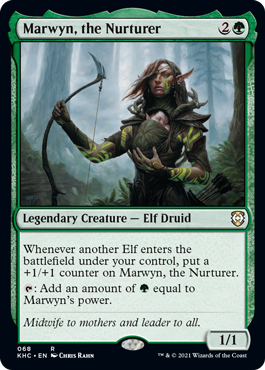
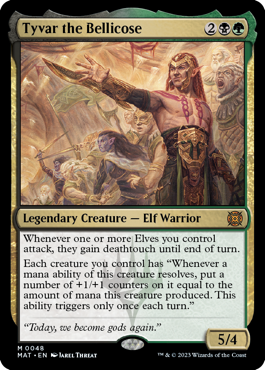

Elf Ball Is Almost Impossible To Stop Once It Starts
Time for the second, much more powerful of the Historic Brawl decks I promised: Elf Ball. A deck that seeks to overrun the opponent with lots of creatures pumped to absurd power by Craterhoof Behemoth. It’s not a new archetype by any measure, and is a common deck in Commander, but, after extensive testing (like, it’s hard to stress how many games I played with various versions of this deck), I’ve streamlined it to brutal, effective efficiency. It still has many creative lines for how you go about it, but the game plan will always be making your opponent stare down lethal damage much, much faster than they expected it to happen.
And, like the article I did for Tom Bombadil, I’ll be breaking down the core cards of Elf Ball into a few sections. This time, though, I won’t be able to list anywhere close to all the pertinent cards. Elf Ball is as good as it is because of the inherent redundancy of elf cards. Many elves do almost the same thing, whether it’s making mana, pumping other elves, or generating swarms. So, to make this efficient, I’ll just look at the ones that have something special about them.
The five categories are:
- Extreme Ramp
- Draw Engines
- Utility Creatures
- Tutors
- Wincons
Unlike some deck lists, you need not focus on protecting any one card. You need to focus on not letting your momentum slow. It’s often correct to let people hit you for damage rather than risk that through chump blocking.
Extreme Ramp
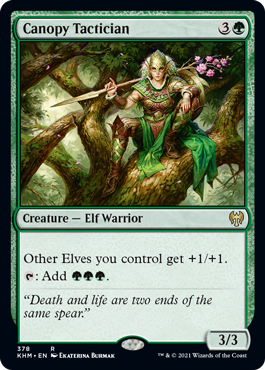
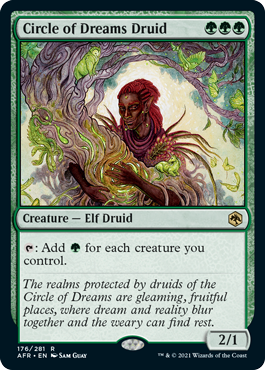
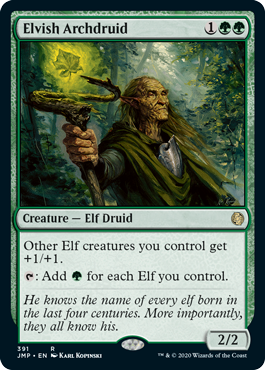

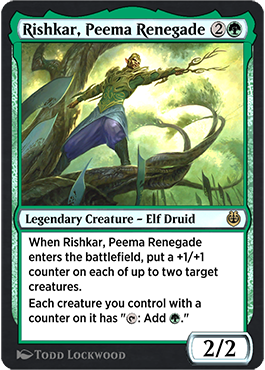
Elf Ball decks need a lot of ramp to cast Craterhoof ahead of curve and to have so much mana floating around that they can play out their entire hands in one go. But, going even more powerful is possible. With our chosen Commander, you can tap your ramp creatures at the end of your opponent’s turns so they can get bigger and bigger (or do it when you block, throwing off people’s combat math).
- Canopy Tactician
- Circle of Dreams Druid
- Elvish Archdruid
- Marwyn, the Nurturer
- Rishkar, Peema Renegade
In all those regards, Marwyn is the best ramp card in the deck—and most opponents know it. Do not play this card with no opportunity to grow Marwyn; she will get targeted by burn and fight spells. Uninterrupted, and especially combined with our Commander, it’s easy to get Marwyn to absurdly high numbers and mana output. The same is true with Elvish Archdruid and Circle of Dream Druid, but opponents seem to notice that less.
Rishkar is the most interesting card out of these because you need to think about what to put counters on. You can get Incubation Druid to tap for more mana early if you give that card a counter. Same with Marwyn. And there are other ways in this deck to get +1/+1 counters onto things that you should consider for mana potential. And, even with all that in mind, sometimes you just want the counters to make a tougher blocker or save a creature from potential burn damage.
Draw Engines






But what are you going to play with all that mana? Well, that’s where having a lot of ways to draw cards comes into play.
- Beast Whisperer
- Herald’s Horn
- Leaf-Crown Visionary
- The Great Henge
- Tribute to the World Tree
- Vanquisher’s Banner
Card draw also helps with recovering from board wipes—and people will try to board wipe you. This is the shortest section, but these are the second most important cards in this Elf Ball deck. So much so, it’s often best to play Draw Engine cards before you go for the most important creature options. The compounding card advantage wins games. Heralds Horn especially improves the longer you have access to it.
Utility Creatures




These creatures are useful in various scenarios. Each tailored to handle a different problem. If you need to tutor for them, don’t hesitate—they can swing the flow of games.
Let’s start with Allosaurus Shephard. This card has a strong first ability: it doesn’t just save creatures from counterspells—a fact that your opponent will sometimes forget. And its second ability doesn’t contradict anthem effects; the power boosts stack. If you have a ton of extra mana, there’s no reason not to fire it off in a pinch.
Golgari Findbroker often secretly wins games. People will try to destroy the fun artifacts and enchantments that make this deck as strong as it is—but usually won’t have a second destroy spell ready. Replaying a Paradox Engine is basically a Wincon by itself. Also, I don’t recall I’ve had this happen yet, but Golgari Findbroker is insurance against someone milling away Craterhoof.
Reclamation Sage is self-explanatory and a must-include. If you suspect your opponent is using an Oblivion Ring-style card, save Rec Sage for it. Unlocking a sealed-down card at the right time can win games. Also, if your opponent uses some card like Go-Shintai of Life’s Origin as their Commander, remember you can destroy enchantment/artifact creatures.
And, finally, Skemfar Shadowsage. I rarely used this like a Gray Merchant to hit the opponent, but it’s a lot of fun when you get that opportunity. Mainly, Skemfar is in the deck to recoup some life after taking a few hits or to undo some of the damage that The One Ring does every turn. Save this card for the optimal health refresh—you’ll want at least three or four life off it.
Tutors
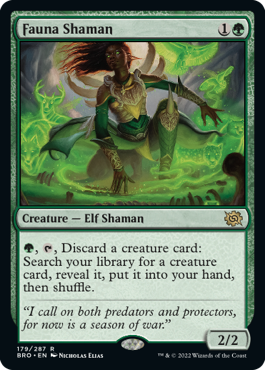
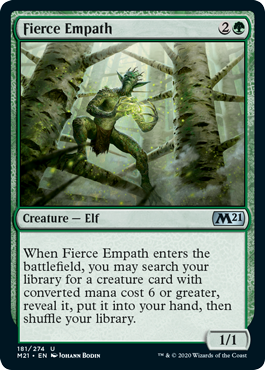
Previous versions of this Elf Ball deck used a few more Tutor cards, but the amount of card draw often does the same thing. You draw the cards you need if you draw a lot of cards.
The main thing these remaining Tutors are here for is to ensure you have Craterhoof when it’s time to win. There’s nothing worse than having all the mana, all the elves, and no way to get in the finishing blow. It’s not out of the realm of possibility to even have enough mana to play Fierce Empath and Craterhoof on the same turn.
Fauna Shaman is the more interesting card of the two, though. Mainly because you often will have difficulty picking what card to pitch to it. Though you will usually have time to find a “good” candidate. No one ever seems to understand how dangerous this card is to have around. I’ve gotten off multiple tutor triggers before my opponent thought to do anything about it.
Wincons

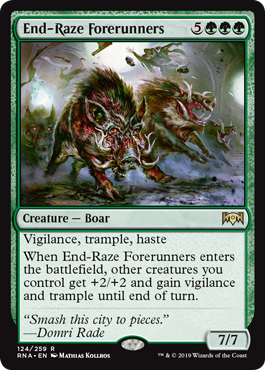


Sometimes opponents can stop Craterhoof. In those cases, we have a few backups.
End-Raze can do similar things in a pinch and is safer if you don’t know you’ll win. You can use End-Raze with your Commander because the vigilance leaves your mana dorks untapped, and thus free to pump.
Speaking of the Commander, he’s a Wincon with a little help. He lets you attack in swarms that’ll leave your opponent scrambling. Deathtouch is so strong by itself and even more so with trample. If you don’t know the rules interaction, you can assign one point of damage per blocker—because that counts as “lethal damage” with deathtouch. The rest tramples over as pure damage. Arena often has newer players, less familiar with this rule, and won’t account for it. Turn off Auto Assign Combat Damage in the settings on Arena to see how this works.
The final Wincon to discuss is the tricks you can do with floating mana and Paradox Engine. Manually tap all your mana-producing elves and artifacts, play a spell, ideally draw a card off some trigger, and then Paradox Engine untaps things. The timer rope will quickly become an annoyance. You can gain lots of life off The Great Henge. You can keep tutoring with Fauna Shaman. You can draw off The One Ring repeatedly. As long as you win on that turn, the damage never happens. Opponents will usually concede before you even get close to every possible game action.
And that’s Elf Ball. It’s a deck that makes you feel absurdly powerful. Generate twenty mana in one go, draw ten cards in a single turn, and cackle to yourself as you do. If you get the right hand, you can win before your opponent has much time to do anything.



Full Deck List
Commander
1 Tyvar the Bellicose (MAT) 48
Deck
1 Unclaimed Territory (XLN) 258
1 Collected Company (AKR) 186
1 Assassin’s Trophy (GRN) 152
1 The One Ring (LTR) 246
1 Golgari Findbroker (GRN) 175
1 Springbloom Druid (MH1) 181
1 Binding the Old Gods (KHM) 206
1 Llanowar Loamspeaker (DMU) 170
1 Silhana Wayfinder (RNA) 141
1 Elvish Clancaller (M19) 179
1 Gala Greeters (SNC) 148
1 Elvish Warmaster (KHM) 167
1 Leaf Gilder (JMP) 408
1 Elvish Archdruid (JMP) 391
1 Plaza of Heroes (DMU) 252
1 Oracle of Mul Daya (JMP) 415
1 The Great Henge (ELD) 161
1 Vanquisher’s Banner (XLN) 251
1 Skyshroud Lookout (J21) 30
1 Incubation Druid (RNA) 131
1 Glissa Sunslayer (ONE) 202
1 Skemfar Shadowsage (KHM) 110
1 Tribute to the World Tree (MOM) 211
1 Circle of Dreams Druid (AFR) 176
1 Nissa, Resurgent Animist (MAT) 22
1 Craterhoof Behemoth (JMP) 385
1 Beast Whisperer (GRN) 123
1 Druid of the Cowl (M19) 177
1 Deathsprout (WAR) 189
1 Elven Chorus (LTR) 160
1 Cultivate (STA) 51
1 Imperious Perfect (LRW) 220
1 A-Harald Unites the Elves (KHM) 213
1 A-Harald, King of Skemfar (KHM) 212
1 Marwyn, the Nurturer (DAR) 172
1 Llanowar Visionary (M21) 193
1 Adaptive Automaton (BRR) 1
1 Arcane Signet (ELD) 331
1 Tireless Provisioner (MH2) 180
1 Gwenna, Eyes of Gaea (BRO) 185
1 Leaf-Crowned Visionary (DMU) 167
1 Agadeem’s Awakening (ZNR) 90
1 Elvish Mystic (M14) 169
1 Herald’s Horn (JMP) 469
9 Swamp (ANA) 5
16 Forest (ZNR) 280
1 Boseiju, Who Endures (NEO) 266
1 Paradox Engine (KLR) 259
1 Command Tower (ELD) 333
1 Fabled Passage (ELD) 244
1 Llanowar Tribe (MH1) 170
1 Castle Garenbrig (ELD) 240
1 Overgrown Tomb (GRN) 253
1 Darkbore Pathway (KHM) 254
1 Deathcap Glade (VOW) 261
1 Blooming Marsh (KLR) 280
1 Rishkar, Peema Renegade (KLR) 179
1 Woodland Cemetery (DAR) 248
1 Llanowar Elves (DAR) 168
1 Castle Locthwain (ELD) 241
1 Allosaurus Shepherd (JMP) 28
1 Takenuma, Abandoned Mire (NEO) 278
1 Fierce Empath (M21) 181
1 Reclamation Sage (M19) 196
1 Icon of Ancestry (M20) 229
1 A-Canopy Tactician (KHM) 378
1 Coalition Construct (Y23) 30
1 Paradise Druid (WAR) 171
1 Jaspera Sentinel (KHM) 178
1 Woodland Mystic (ANB) 109
1 Elvish Rejuvenator (M19) 180
1 End-Raze Forerunners (RNA) 124
1 A-Thornmantle Striker (KHM) 387
1 Fauna Shaman (BRO) 179
1 Temple of Malady (M21) 253
1 Growing Rites of Itlimoc (XLN) 191
Possibly Related Posts:



Comments